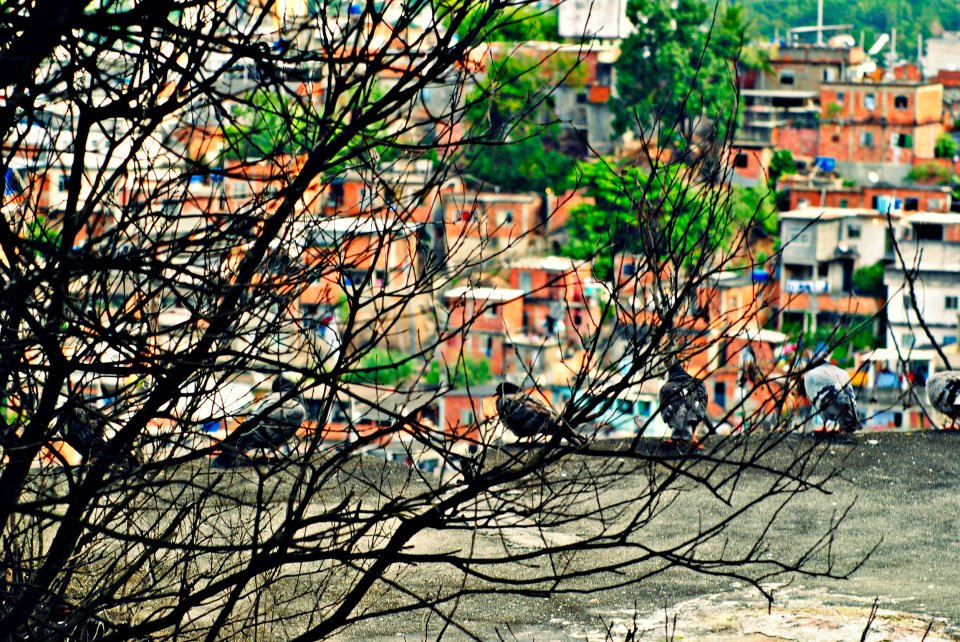2012 Update & Next Up in 2013
December 31, 2012–As 2012 draws to a close, there is so much to share, so much to be grateful for, so much to thank you for.

Today, people who follow Rio de Janeiro look to CatComm for timely, unique and compelling information about the city’s development practices and future outlook. Journalists, citizens and policy-makers who follow urban development in Rio, especially housing, look to CatComm as an authority on these issues.
Below, we’ve summarized this year’s accomplishments and encourage you to send us your reflections. It’s thanks to collaborator input over the years that we’ve developed creatively and achieved so much.
Here are the highlights from 2012:
- Winner of the John D. Lange International Award: This month, CatComm Executive Director Theresa Williamson was awarded the 2012 John D. Lange International Award from the National Association of Housing and Redevelopment Officials, a US and international network of housing professionals. The award recognizes a person in the housing and community development field who has made an outstanding contribution toward international understanding and exchange of international experience in the housing field.
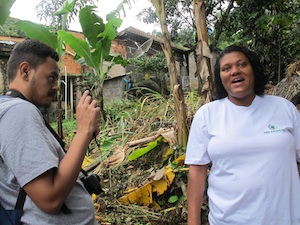 Favela As A Sustainable Model film: For the Rio+20 UN Conference in June this year, CatComm produced this twenty-six minute documentary exploring the ways in which sustainable principles are in the very fabric of favela life and also the development difficulties favelas face due to state neglect. The film premiered with two showings during Rio+20 at the People’s Summit and the Museu da Republica and has since been shown and debated in the Vila Margarida and Muzema communities, at Brown University, Pratt Institute, Georgia State University, Goucher College, and Roger Williams University. It has received over 3,800 hits on YouTube and won Best Mid-Length Film Award at the Cine Periferia Pai D’égua Film Festival in Belém.
Favela As A Sustainable Model film: For the Rio+20 UN Conference in June this year, CatComm produced this twenty-six minute documentary exploring the ways in which sustainable principles are in the very fabric of favela life and also the development difficulties favelas face due to state neglect. The film premiered with two showings during Rio+20 at the People’s Summit and the Museu da Republica and has since been shown and debated in the Vila Margarida and Muzema communities, at Brown University, Pratt Institute, Georgia State University, Goucher College, and Roger Williams University. It has received over 3,800 hits on YouTube and won Best Mid-Length Film Award at the Cine Periferia Pai D’égua Film Festival in Belém.
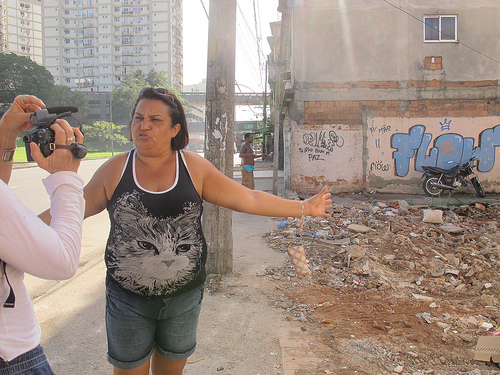 RioOnWatch: CatComm’s community news site publishing favela perspectives on Rio’s transformations in the lead-up to the 2016 Olympics has grown enormously in readership and impact. 176 articles were published throughout the year, now mapped, yielding a quadrupling of total monthly site visits from 2,750 in January to 9,560 last month. This reflects the growing interest in Rio de Janeiro’s development, the increasing diversity and quality of reporting on the site, and the growing use of the site by opinion leaders worldwide. Accompanying this expansion is a dramatic growth in our social media reach, from 14,000 a year ago to 33,470 in November, with 42,000 people in our top month, August. Our monthly Rio News Digest has also become a staple among followers of Rio de Janeiro’s urban policies: December | November | October | September | August | July | June | May | April | March| February | January.
RioOnWatch: CatComm’s community news site publishing favela perspectives on Rio’s transformations in the lead-up to the 2016 Olympics has grown enormously in readership and impact. 176 articles were published throughout the year, now mapped, yielding a quadrupling of total monthly site visits from 2,750 in January to 9,560 last month. This reflects the growing interest in Rio de Janeiro’s development, the increasing diversity and quality of reporting on the site, and the growing use of the site by opinion leaders worldwide. Accompanying this expansion is a dramatic growth in our social media reach, from 14,000 a year ago to 33,470 in November, with 42,000 people in our top month, August. Our monthly Rio News Digest has also become a staple among followers of Rio de Janeiro’s urban policies: December | November | October | September | August | July | June | May | April | March| February | January.
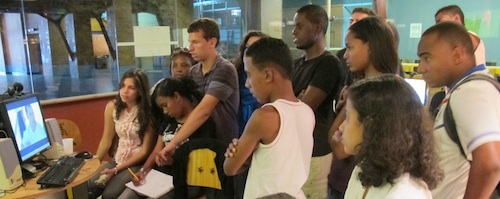 Community Journalism Initiative: Launched in November, the CJI is an outgrowth of our community journalism trainings. Counting on the dozens of effective journalism, photography and media training programs preparing favela communicators today, the program harnesses their potential through RioOnWatch. Dozens of community journalists have pitched stories from all administrative regions of the city. Eight stories have been selected for payment and publication thus far, with a focus on Providência and Vidigal favelas in these two initial launch months.
Community Journalism Initiative: Launched in November, the CJI is an outgrowth of our community journalism trainings. Counting on the dozens of effective journalism, photography and media training programs preparing favela communicators today, the program harnesses their potential through RioOnWatch. Dozens of community journalists have pitched stories from all administrative regions of the city. Eight stories have been selected for payment and publication thus far, with a focus on Providência and Vidigal favelas in these two initial launch months.
- International Favela Perceptions Survey & Media Monitoring
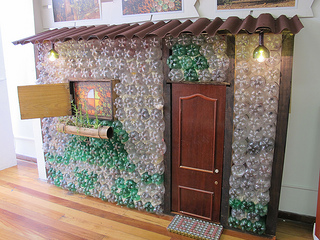 : CatComm developed and implemented the first multi-city international favela perceptions survey, with a total 725 responses from Rio and major cities in North America. The findings showed that visiting a favela significantly changes perceptions: 79% of North Americans who hadn’t been to a favela in Rio viewed them negatively, while72% of those who had visited viewed them favorably. We also conducted research into how favelas are portrayed in the media. This language-tracking of mainstream international coverage of Rio’s favelas and local commentary on media by Rio residents revealed that favelas continue to be negatively typecast as violent slums, thereby reinforcing stigmas and hindering possibilities for integration and self-determined development.
: CatComm developed and implemented the first multi-city international favela perceptions survey, with a total 725 responses from Rio and major cities in North America. The findings showed that visiting a favela significantly changes perceptions: 79% of North Americans who hadn’t been to a favela in Rio viewed them negatively, while72% of those who had visited viewed them favorably. We also conducted research into how favelas are portrayed in the media. This language-tracking of mainstream international coverage of Rio’s favelas and local commentary on media by Rio residents revealed that favelas continue to be negatively typecast as violent slums, thereby reinforcing stigmas and hindering possibilities for integration and self-determined development.
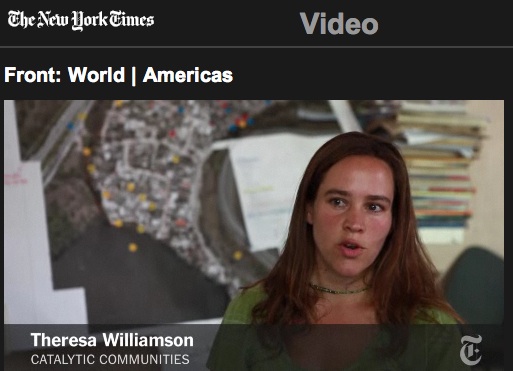 Two impactful opinion pieces in the NY Times: In April Executive Director Theresa Williamson wrote the debate piece A Missed Opportunity in Rio, following the NYT’s first coverage of forced evictions in Rio, also facilitated by us and featuring a video report in which Theresa appeared. Then in August, the day after the Olympic torch was passed from London to Rio, the NYT published the Op-Ed In the Name of the Future, Rio Is Destroying Its Past by CatComm’s Theresa Williamson and photographer and community leader Maurício Hora. Telling the history of Latin America’s first favela, Morro da Providência, and commenting on the forced evictions that are set to remove almost a third of the community, the piece generated enormous international interest and dialogue around the preparations for the 2016 Olympics and the legacy for Rio’s favelas. Simultaneously published in Portuguese, the piece had a significant local impact, triggering dozens of related and follow-up stories in the Brazilian media and strengthening the community’s resistance and negotiations against forced evictions.
Two impactful opinion pieces in the NY Times: In April Executive Director Theresa Williamson wrote the debate piece A Missed Opportunity in Rio, following the NYT’s first coverage of forced evictions in Rio, also facilitated by us and featuring a video report in which Theresa appeared. Then in August, the day after the Olympic torch was passed from London to Rio, the NYT published the Op-Ed In the Name of the Future, Rio Is Destroying Its Past by CatComm’s Theresa Williamson and photographer and community leader Maurício Hora. Telling the history of Latin America’s first favela, Morro da Providência, and commenting on the forced evictions that are set to remove almost a third of the community, the piece generated enormous international interest and dialogue around the preparations for the 2016 Olympics and the legacy for Rio’s favelas. Simultaneously published in Portuguese, the piece had a significant local impact, triggering dozens of related and follow-up stories in the Brazilian media and strengthening the community’s resistance and negotiations against forced evictions.
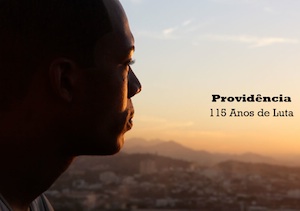 Providência: 115 Years of Struggle: This short film, launched in conjunction with the NY Times Op-ed, explores the historic significance and current evictions plight of Rio’s first favela, which this year celebrates its 115th anniversary. Produced by filmmaker Haimy Assefa during her internship with us, the film reinforced the impact of the NY Times piece, has been viewed 4,500 times on YouTube and was shown at the National Association of Housing and Redevelopment Officials Annual Conference to 12,000 housing sector professionals. The film has been selected for the Brazil Film Festival in Australia in February 2013.
Providência: 115 Years of Struggle: This short film, launched in conjunction with the NY Times Op-ed, explores the historic significance and current evictions plight of Rio’s first favela, which this year celebrates its 115th anniversary. Produced by filmmaker Haimy Assefa during her internship with us, the film reinforced the impact of the NY Times piece, has been viewed 4,500 times on YouTube and was shown at the National Association of Housing and Redevelopment Officials Annual Conference to 12,000 housing sector professionals. The film has been selected for the Brazil Film Festival in Australia in February 2013.
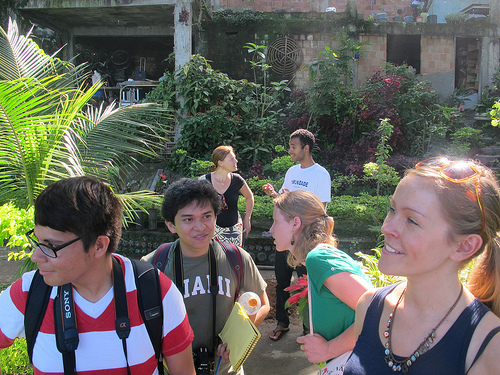 Workshops and Educational Community Visits during Rio+20: With thousands of people from around the world in Rio for the UN Conference, Rio+20 provided a valuable opportunity to present and discuss the city’s favelas. At the People’s Summit, CatComm organized the debate Composing a Collective Narrative of Rio’s Favelas with community leaders from five very different favelas across the city to discuss major themes, such as real estate, economy and stigma, that can be said to define Rio’s favelas today. Throughout the conference CatComm organized Educational Community Visits to a wide range of favelas across the city for visiting academics, researchers and journalistsinterested in learning more about Rio’s favelas from community leaders themselves.
Workshops and Educational Community Visits during Rio+20: With thousands of people from around the world in Rio for the UN Conference, Rio+20 provided a valuable opportunity to present and discuss the city’s favelas. At the People’s Summit, CatComm organized the debate Composing a Collective Narrative of Rio’s Favelas with community leaders from five very different favelas across the city to discuss major themes, such as real estate, economy and stigma, that can be said to define Rio’s favelas today. Throughout the conference CatComm organized Educational Community Visits to a wide range of favelas across the city for visiting academics, researchers and journalistsinterested in learning more about Rio’s favelas from community leaders themselves.
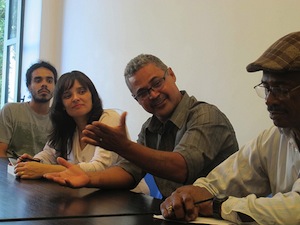 Two Workshops with Architects and Community Leaders at Studio X: Architects from the Swiss University ETH Zurich launched a public exhibition Favela x City Exchange on June 26th and brainstorming session with community leaders on June 25th in partnership with Catalytic Communities. Later in the year, CatComm and ETH Zurich teamed up once again for a Brazilian Popular Architecture workshop on November 1st with architecture students and community leaders to exchange knowledge and experience with a view to creating sustainable solutions to housing problems in informally built communities.
Two Workshops with Architects and Community Leaders at Studio X: Architects from the Swiss University ETH Zurich launched a public exhibition Favela x City Exchange on June 26th and brainstorming session with community leaders on June 25th in partnership with Catalytic Communities. Later in the year, CatComm and ETH Zurich teamed up once again for a Brazilian Popular Architecture workshop on November 1st with architecture students and community leaders to exchange knowledge and experience with a view to creating sustainable solutions to housing problems in informally built communities.
 Monitoring Morar Carioca: Morar Carioca is Rio de Janeiro’s favela upgrading program that, though signed several years ago, is only now kicking in. Throughout the year we’ve dedicated interns and international observers to documenting communities prior to and during project implementation, helping influence said implementation in participatory ways.
Monitoring Morar Carioca: Morar Carioca is Rio de Janeiro’s favela upgrading program that, though signed several years ago, is only now kicking in. Throughout the year we’ve dedicated interns and international observers to documenting communities prior to and during project implementation, helping influence said implementation in participatory ways.
- Shaping the International Debate on Favelas through Media: With the increased global focus on Rio de Janeiro, attention from the NYT pieces and growing influence of RioOnWatch, CatComm has been increasingly sought out to provide information and interviews for publications from around the world on Rio’s favelas. In 2012 we were interviewed by media sources of all types on all continents, including: The New York Times; Huffington Post; Christian Science Monitor; The Nation; NPR; NewsTalk Ireland; Edge of Sports; FM4 Austria; Harvard Review of Latin America; Next American City; UN MediaGlobal News; The Rio Times; Urb.im; Chicagoano; and Rio Real Blog. CatComm ED Theresa Williamson was solicited for opinion pieces featured in the US, Brazilian, and German press. And in the Brazilian press: Folha de São Paulo; O Globo; Meia Hora; O Dia; UOL; Yahoo! Notícias; Agência Brasil; Destak; EMBARQ; and Direito a Moradia, among others.
- On-the-ground Observance of London Olympics: In July 2012, CatComm Executive Director Theresa Williamson visited London for the 2012 Olympics, meeting with international Olympics researchers and members of civil society organizations who’ve witnessed a range of impacts of the Games on the ground; speaking at the rally organized by local activists on the Olympics opening day; meeting and speaking with journalists from a variety of publications; visiting the recently confirmed East London Community Land Trust site and learning about the future project; and meeting with the National Community Land Trust Network to learn of the UK experience with land trusts and how these might be adapted to Rio’s favelas.
 Public Talks: CatComm reached an estimated audience of 400 North American researchers and professors through public talks at Berea College, Brown University, Roger Williams University, Pratt Institute, Goucher College, and Georgia State University, along with 300 during presentations for the American Society of Rio de Janeiro, Studio X, and London Olympic opening day rally.
Public Talks: CatComm reached an estimated audience of 400 North American researchers and professors through public talks at Berea College, Brown University, Roger Williams University, Pratt Institute, Goucher College, and Georgia State University, along with 300 during presentations for the American Society of Rio de Janeiro, Studio X, and London Olympic opening day rally.
- In 2012, Catalytic Communities also facilitated: (1) The English translation of the Popular Committee for the World Cup and Olympics’ Dossier on Mega-Events and Human Rights Violations in Brazil; (2) An art project by New York photographer Marc Ohrem-Leclef of portraits of residents and communities threatened with eviction; (3) A graffiti intervention in Morro da Providência by artist intern Diego Camposeco working with community members to create a mural protest against forced evictions in the favela; and (4) Asset mapping the Pica-Pau community in Cordovil by our summer intern Rexy Josh Dorado working in collaboration with community leaders and Ecocity Builders to map the favela’s assets and needs, creating valuable tools for the community to demand and develop solutions.
Note that everything listed here was made possible for an annual budget of just over $100,000. We estimate that for every $1 CatComm spends, collaborators kick in at least $4 in in-kind support, ranging from translation to workshop space, legal support to outreach, technical support and graphic design. We’re able to leverage these resources because we operate as a network of dedicated collaborators committed to timely and strategic projects in function of a shared mission, rather than a large project-based NGO. And, thanks to our strong relationships with communities, researchers, and journalists, CatComm has made it easy for interested collaborators to hit the ground running.
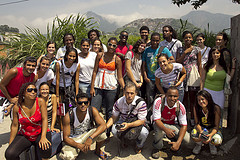 This means we need basic resources simply to plan, engage partners, coordinate, and guarantee implementation of specific timely projects. We have designed ourselves this way to maintain qualities like flexibility, commitment, agility and dynamism. This way we can respond to opportunities and needs, both of which change on a daily basis, and are not slowed by economic cycles and fashions in funding. Because we undertake timely distinct pilot projects in new unmet terrain, we help unlock and establish the potential of these new terrains, from social media to community organizing workshops in Rio. And as a result our work is increasingly looked to as a model for community advocacy worldwide. And this work is all made possible thanks to you—our collaborators.
This means we need basic resources simply to plan, engage partners, coordinate, and guarantee implementation of specific timely projects. We have designed ourselves this way to maintain qualities like flexibility, commitment, agility and dynamism. This way we can respond to opportunities and needs, both of which change on a daily basis, and are not slowed by economic cycles and fashions in funding. Because we undertake timely distinct pilot projects in new unmet terrain, we help unlock and establish the potential of these new terrains, from social media to community organizing workshops in Rio. And as a result our work is increasingly looked to as a model for community advocacy worldwide. And this work is all made possible thanks to you—our collaborators.
Our Plans for 2013:
In applying our 4-Prong Strategy of (1) Strategic training and networking favela activists with broad networks of support, (2) Broadly communicating the issues and values of the favela based on community perspectives, (3)Developing and proving the value of participatory planning methodologies; and (4) Advocating on behalf of inclusive, integrative and participatory policies; with your continued support in 2013 CatComm will:
- Continue expanding the breadth, quality and quantity of community-based reporting for RioOnWatch, as well as expanding readership;
- Expand our perceptions survey, Morar Carioca monitoring, media monitoring and support, Educational Community Visits, and public talks;
- Develop and advocate on behalf of cutting edge land policy recommendations through an Affordable Housing Policy Proposal for the City of Rio that offers titling while preserving community and culture;
- Implement Community Organizing Workshops across Rio aimed at developing participatory models, disseminating resistance strategies, and informing residents of increasing pressures and the widespread processes underway across the city;
- Produce a “Story of the Favela” graffiti-based animated video illustrating the history of the favela, from how/why they were first settled, through decades of development and self-help efforts, to today, showing community concerns and accomplishments and current risks.
As 2012 comes to a close, we rely on your continued generosity now more than ever to ensure our work continues into the new year. If you value our work, please take the time to make a final year-end donation to Catalytic Communities before December 31st.
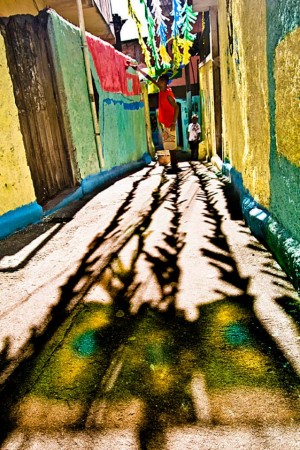 We have also calculated that were we able to ensure $50,000 of our annual budget through a group of Champions–supporters committed to donating a total of $50k annually through 2016–core staff would have almost one month’s-worth more time per year to dedicate to our mission and thus generate significantly more impact.
We have also calculated that were we able to ensure $50,000 of our annual budget through a group of Champions–supporters committed to donating a total of $50k annually through 2016–core staff would have almost one month’s-worth more time per year to dedicate to our mission and thus generate significantly more impact.
As such, we ask donors to DONATE HERE NOW or, if you are willing and able, please SIGN UP AS A CHAMPION HERE committed to guaranteeing our work by donating annually through 2016.
Knowing we can count on this support CatComm will be able to confidently address each of our four prongs and continue to make long-term systematic urban change in Rio de Janeiro, establishing a model for cities around the world.
Best wishes for a healthy, joyous, meaningful and healthy 2013!
–CatComm Staff
Featured top image by Felipe Paiva.

